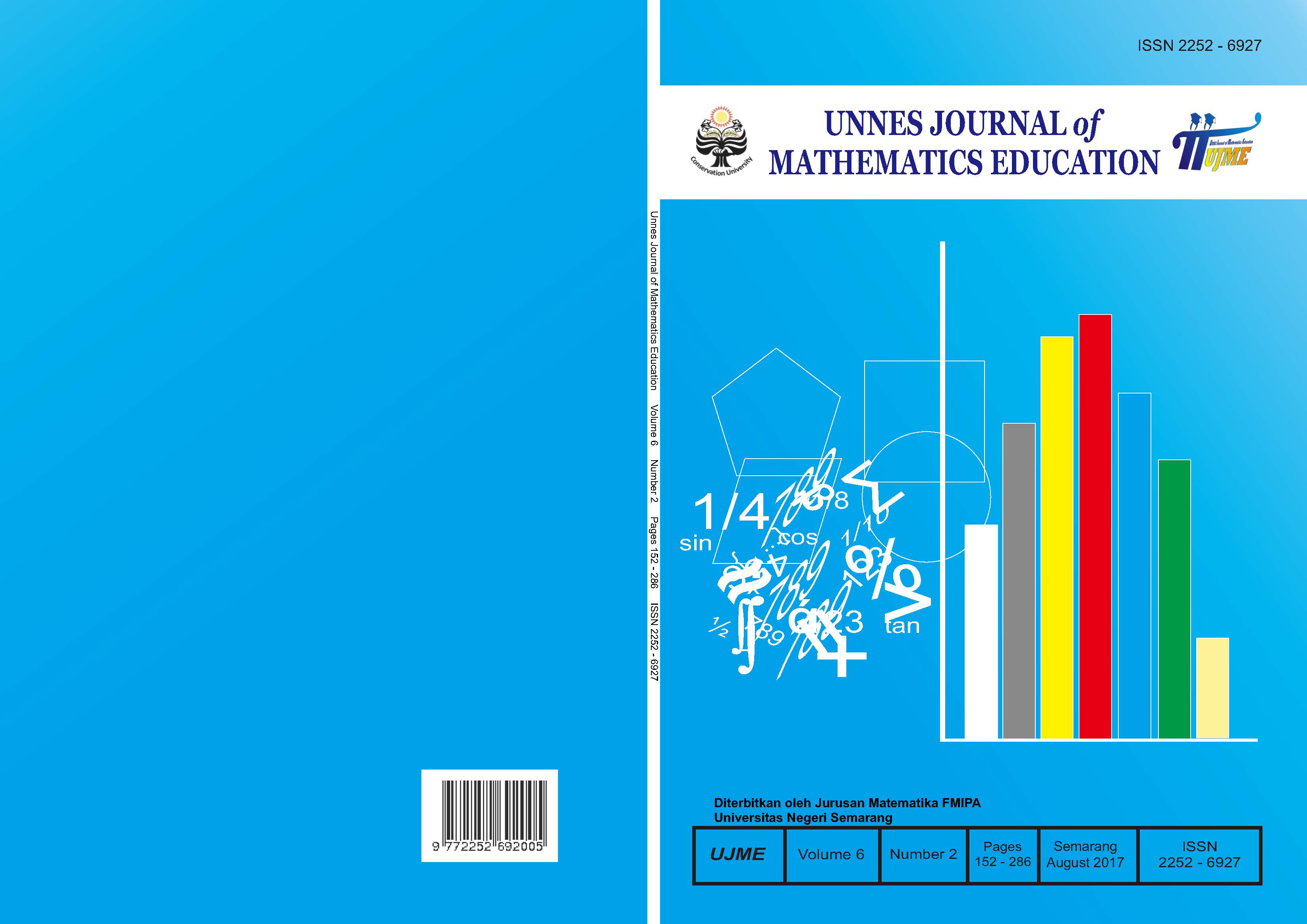Mathematical Communication Ability by Grade VII Students Using a Themed Problem Based Learning with Scaffolding on Rectangle Materials
##plugins.themes.academic_pro.article.main##
Abstract
The aim of research to test students' mathematical communication used themed of PBL with scaffolding, themed of PBL and PBL achieve mastery learning;to test students' mathematical communication that used the themed of PBL with scaffolding, themed of PBL and PBL; and to test students' mathematical communication for the low, medium group, and a high-group themed of PBL with scaffolding, themed of PBL and PBL. This type of research is quantitative research. The Population is seventh grade students of SMPN 22 Semarang and the sample class VII E, F and VII VII G. Used normality test, homogenity test, equality test on average, the proportion of one-party test, one way anova test, and scheffe test. The results showed that (1) Student’s mathematical communication ability using themed of PBLwith Scaffolding strategy,themed of PBL, and PBL achieve the completeness of learning, (2) there is a difference in the classroom using the themed of PBL with scaffolding, themed of PBL, as well as PBL, (3) For the low, medium, high and there is a difference in the classroom using the themed of PBL with scaffolding, themed of PBL and PBL.
##plugins.themes.academic_pro.article.details##
References
Anghileri. (2006). Scaffolding Practices That Enhance Mathematics Learning. Journal of Mathematics Teacher Education, 9, 33-52. Tersedia di http://link.springer.com/article/10.1007%2Fs10857-006-9005-9 [diakses 9-1-2017]
Asikin, M. & Junaedi, I. (2013). Kemampuan Komunikasi Matematika Siswa SMP dalam Setting Pembelajaran RME (Realistic Mathematisc Education). Unnes Journal of Mathematics Education, 2 (1), 203-223.
Bikmaz, Celebi, & Ata. 2010. Scaffolding Strategies Applied by Student Teachers to Teach Mathematics. The International Journal of Research in Teacher Education, 1 (specialissue), 25-36. Tersedia di http://dergipark.ulakbim.gov.tr/ijrte/article/download/5000041450/500003890 [diakses tanggal 11-1-2017]
Fathiya R.N., Agoestanto A., & Kurniasih A.W. (2014). Identifikasi Tahap Berpikir Kreatif Menggunakan PBL dengan Tugas Pengajuan Masalah. Unnes Journal of Mathematics Education, 3 (1), 72-80.
Hadi, S. (2004). Metodologi Research (Jilid 4). Yogyakarta: ANDI.
Hosnan, M. (2014). Pendekatan Saintifik dan Kontekstual dalam Pembelajaran ABAD 21. Bogor: Ghalia Indonesia.
Hudojo, H. (2005). Pengembangan Kurikulum dan Pembelajaran Matematika. Malang: Universitas Malang.
Lange, V.L. (2002). Intructional Scaffolding: A Teaching Strategy. Tersedia di http://daretodifferentiate.wikispaces.com/file/view/Cano+Paper.doc [diakses 9-2-2016]
Masrukan. (2013). Asesmen Otentik Pembelajaran Matematika. Semarang : Universitas Negeri Semarang.
OECD. (2012). PISA 2012 Results in Focus. What 15-Year-Olds Know and What They Can Do Alt What They Know. Tersedia di https://www.oecd.org/pisa/keyfindings/pisa-2012-results-overview.pdf [diakses 11-1-2017]
Oktiwulan, V. (2015). Implementasi Model Advance Organizer dan Model PBL Berbantuan Kartu Masalah Terhadap Kemampuan Komunikasi Matematik Peserta Didik Kelas VII. Skripsi. Semarang: Universitas Negeri Semarang.
Qohar, A. (2011) Mathematical Communication: What And How To Develop It in Mathematics Learning?. Procceding International Seminar and the Fourth National Conference on Mathematics Education 2011. Yogyakarta: Universitas Negeri Yogyakarta. Tersedia di : https://core.ac.uk/download/pdf/11058861.pdf [diakses 24-1-2017]
Rahayu, E.A., Waluyo, S.B., & Sugiman. 2014. Keefektifan Model Arias Berbantuan Kartu Masalah Untuk Meningkatkan Kemampuan Komunikasi Matematis Siswa. Kreano Matematika FMIPA UNNES, 5(1), 41-49.
Rifa’i, A. & Anni, A. T. (2012). Psikologi Pendidikan. Semarang: Pusat Pengembangan MKU-MKDK UNNES.
Septiani, M.D., Sukestiyarno, & Suyitno, A. (2013). Pembentukan Karakter dan Komunikasi Matematika melalui Model Problem Posing Berbantuan Scaffolding Materi Segitiga Kelas VII. Kreano Matematika FMIPA UNNES, 4 (1), 41-49.
Sudjana. (2005). Metoda Statistika. Bandung: PT Tarsito Bandung.
Sukestiyarno. (2013). Olah Data Peneltian Berbantuan SPSS. Semarang: Universitas Negeri Semarang
Trianto. (2007). Model-model Pembelajarn Inovatif Berorientasi Konstruktivistik. Jakarta: Prestasi Pustaka.
Uden, L., & Beaumont, C. (2006). Technology and Problem Based Learning. London: Idea Grup Inc.Tersedia di https://www.scribd.com/document/98625661/eBook-Technology-PBL-Complete [diakses 9-2-2017]
Zaini N.K., Wuryanto, & Sutarto. (2016). Peningkatan Kemampuan Pemecahan Masalah Karakter Siswa Kelas VII melalui Model PBL Berbantuan Scaffolding. Unnes Journal of Mathematics Education, 5(1),62-68.
